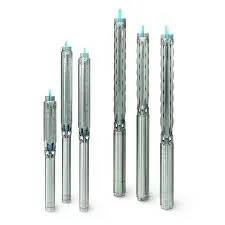Aug . 31, 2024 02:52 Back to list
submersible deep well water pump specifications
Understanding Submersible Deep Well Water Pump Specifications
Submersible deep well water pumps play a vital role in various applications including agricultural irrigation, domestic water supply, and industrial processes. These pumps are designed to be submerged in water, allowing them to efficiently draw water from deep underground sources. To make an informed decision when purchasing a submersible pump, one must understand its specifications and how they impact performance.
1. Pump Type
Submersible pumps are generally categorized based on their design and application. The most common types are centrifugal pumps, which use rotational energy to move water. In deep well applications, they are designed to handle high heads (the vertical distance the water must be lifted). It's crucial to choose a pump type that matches the specific needs of your application.
2. Capacity and Flow Rate
One of the most critical specifications is the pump’s capacity, often measured in gallons per minute (GPM) or liters per minute (LPM). The flow rate indicates how much water the pump can deliver in a given timeframe. When selecting a pump, consider the demand of your application; for instance, agricultural applications may require a higher flow rate compared to domestic use. Ensuring the pump can meet peak demand without overexertion is essential for long-term reliability.
3. Head Height
The head height is another vital specification that refers to the maximum vertical distance a pump can raise water. This measurement is expressed in feet or meters and is crucial in deep well applications where the water source is situated deep underground. It's important to choose a pump capable of providing sufficient head height based on the depth of the water table, as well as any additional elevation changes in the discharge line.
4. Power Requirements
submersible deep well water pump specifications

The power supply for submersible pumps typically involves either electric motors or diesel engines. Electric submersible pumps are popular due to their efficiency and ease of use. However, power supply availability and operational costs are important considerations. Make sure to check the voltage and phase requirements (single-phase or three-phase) to ensure compatibility with your power source.
5. Construction Materials
Given the harsh conditions that submersible pumps may face—such as corrosive water or high levels of sediment—construction material is a key specification. Stainless steel and thermoplastic components are commonly used for their durability and resistance to rust and corrosion. When choosing a pump, consider the water quality and choose materials that can withstand the specific challenges posed by your environment.
6. Motor Protection
Motor protection mechanisms, such as thermal overload protection or submersible motor enclosures, are crucial for ensuring pump longevity. These features help prevent overheating and failure, especially when the pump operates at high capacities for extended periods. Therefore, opting for pumps with robust motor protection systems can save you from costly repairs and replacements.
7. Efficiency Ratings
Finally, always consider the energy efficiency of the pump. Look for energy rating labels or specifications that indicate the pump's efficiency. Higher efficiency not only translates to lower operational costs but also reduces your carbon footprint, making it a more environmentally friendly option.
Conclusion
Understanding the specifications of submersible deep well water pumps is essential for making an informed purchasing decision. By considering factors such as pump type, capacity, head height, power requirements, construction materials, motor protection, and efficiency ratings, users can select the right pump that meets their specific needs and applications. Whether for agricultural, domestic, or industrial uses, the right submersible pump can significantly enhance water management and usage efficiency.
-
Submersible Water Pump: The Efficient 'Power Pioneer' of the Underwater World
NewsJul.01,2025
-
Submersible Pond Pump: The Hidden Guardian of Water Landscape Ecology
NewsJul.01,2025
-
Stainless Well Pump: A Reliable and Durable Pumping Main Force
NewsJul.01,2025
-
Stainless Steel Submersible Pump: An Efficient and Versatile Tool for Underwater Operations
NewsJul.01,2025
-
Deep Well Submersible Pump: An Efficient 'Sucker' of Groundwater Sources
NewsJul.01,2025
-
Deep Water Well Pump: An Efficient 'Sucker' of Groundwater Sources
NewsJul.01,2025
-
 Submersible Water Pump: The Efficient 'Power Pioneer' of the Underwater WorldIn the field of hydraulic equipment, the Submersible Water Pump has become the core equipment for underwater operations and water resource transportation due to its unique design and excellent performance.Detail
Submersible Water Pump: The Efficient 'Power Pioneer' of the Underwater WorldIn the field of hydraulic equipment, the Submersible Water Pump has become the core equipment for underwater operations and water resource transportation due to its unique design and excellent performance.Detail -
 Submersible Pond Pump: The Hidden Guardian of Water Landscape EcologyIn courtyard landscapes, ecological ponds, and even small-scale water conservancy projects, there is a silent yet indispensable equipment - the Submersible Pond Pump.Detail
Submersible Pond Pump: The Hidden Guardian of Water Landscape EcologyIn courtyard landscapes, ecological ponds, and even small-scale water conservancy projects, there is a silent yet indispensable equipment - the Submersible Pond Pump.Detail -
 Stainless Well Pump: A Reliable and Durable Pumping Main ForceIn the field of water resource transportation, Stainless Well Pump has become the core equipment for various pumping scenarios with its excellent performance and reliable quality.Detail
Stainless Well Pump: A Reliable and Durable Pumping Main ForceIn the field of water resource transportation, Stainless Well Pump has become the core equipment for various pumping scenarios with its excellent performance and reliable quality.Detail
